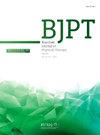对肩袖相关性肩痛患者进行运动动员对肩关节活动范围和疼痛的直接影响:随机对照试验(进化试验)。
IF 3.2
3区 医学
Q1 ORTHOPEDICS
引用次数: 0
摘要
背景:肩袖运动疗法(MWM)通常用于治疗肩袖相关性疼痛(RCRSP)患者。然而,支持肩袖运动疗法对改善肩袖相关性疼痛(RCRSP)患者的运动范围(ROM)和疼痛疗效的证据却很有限:目的:评估MWM对RCRSP患者疼痛角度发作的直接影响:方法:63 名 RCRSP 患者随机接受 3 组重复 10 次的 MWM 或假 MWM,每组之间休息一分钟。在基线以及接受第一组和第三组 10 次重复的干预后,测量疼痛发作的角度(主要结果)、休息时的疼痛强度以及肩关节外展至疼痛发作时的疼痛强度。其他次要结果在基线和接受 3 组 10 次重复干预后或干预后 1、2、3、5 和 7 天进行测量:与假 MWM 组相比,MWM 组在接受第一组和第三组 10 次重复干预后,分别比基线提高了 6.5°(95 % CI -0.9,13.9)和 13.7°(95 % CI 6.3,21.1):结论:MWM 可改善 RCRSP 患者在接受 3 组 10 次重复的 MWM 后疼痛的角度。这项研究为使用MWM治疗RCRSP患者提供了初步支持,并为临床医生决定在临床实践中使用MWM的剂量提供了一些指导。本文章由计算机程序翻译,如有差异,请以英文原文为准。
The immediate effects of mobilization with movement on shoulder range of motion and pain in patients with rotator cuff-related shoulder pain: A randomized controlled trial (Evolution Trial)
Background
Mobilization with movement (MWM) is commonly used to treat patients with rotator cuff-related shoulder pain (RCRSP). However, the evidence supporting MWM efficacy for improving range of motion (ROM) and pain in patients with RCRSP is limited.
Objectives
To assess the immediate effects of MWM on the angular onset of pain in patients with RCRSP.
Methods
Sixty-three participants with RCRSP were randomized to receive 3 sets of 10 repetitions of MWM or sham MWM with a minute rest between each set. The angular onset of pain (primary outcome), and pain intensity at rest and during shoulder abduction to the onset of pain were measured at baseline, and after receiving the 1st and 3rd sets of 10 repetitions of interventions. Other secondary outcomes were measured at baseline and after receiving 3 sets of 10 repetitions of interventions or 1, 2, 3, 5, and 7 days after interventions.
Results
Compared with the sham MWM group, the MWM group had an additional improvement of 6.5° (95 % CI -0.9, 13.9) and 13.7° (95 % CI 6.3, 21.1) (from baseline) after receiving the 1st and 3rd sets of 10 repetitions of interventions, respectively.
Conclusion
MWM improves the angular onset of pain after 3 sets of 10 repetitions of MWM in patients with RCRSP. This study provides preliminary support for the use of MWM in treating patients with RCRSP and provides some guidance for clinicians to decide the MWM dosage to be used in clinical practice.
求助全文
通过发布文献求助,成功后即可免费获取论文全文。
去求助
来源期刊
CiteScore
6.10
自引率
8.80%
发文量
53
审稿时长
74 days
期刊介绍:
The Brazilian Journal of Physical Therapy (BJPT) is the official publication of the Brazilian Society of Physical Therapy Research and Graduate Studies (ABRAPG-Ft). It publishes original research articles on topics related to the areas of physical therapy and rehabilitation sciences, including clinical, basic or applied studies on the assessment, prevention, and treatment of movement disorders.

 求助内容:
求助内容: 应助结果提醒方式:
应助结果提醒方式:


